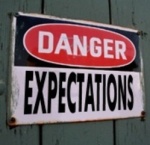
Identify what your customers don't need:
In my experience, I have always found a "NOT TO DO" list very helpful. The list of things you will not deliver sets boundaries for your project, and it provides a comprehensive basis for scoping discussions with your users and customers. To define a "NOT TO DO" list, you can ask various questions to your customers, such as: What is of the least value to you? What if we don't deliver this component? What will be an acceptable project? Trust me, this approach will go a long way in defining the actual scope of your project.

Communicate ONLY realistic expectations:
During my career, I have been a part of numerous projects where expectations were unrealistic. Manager/Client will over promise to their customers/stakeholders to gain their business/trust, and they fail to realize that they will lose their credibility when they can't stand up to their expectations. Thus, I would suggest you to carefully define the scope of your project. If you suspect any infeasible components in your project, then investigate those issues before promising anything to your customers. If your investigation shows that something expected by your customers is probably impossible, then communicate your findings with them. In this way, you will earn their trust and gain some credibility by involving them into decision making. After all, it is always better for projects to under promise and over deliver than to do the reverse.

Revisit requirements often:
Those days are gone, when we used to have rigid requirements for our projects, which hardly ever changed. Today's Project Management is a whole new game. Though our project might not change, the external environment will change, which will in turn change the requirements of the project. Thus, I would recommend you to implement a continuous feedback loop in your project management lifecycle, and revisit your requirements often. You can use various mechanisms to do this, such as: ongoing project discussions with your customers; demonstration of prototypes, pilots, mock-ups, and intermediate deliverables; feedback from testing; and other periodic customer interaction.
I hope, these tips will help you to manage changes in your project due to change in customer expectations. Let me know, if you have any other suggestions regarding the same. Thanks. – Bhavin Gandhi


